warning light VOLVO V4 2003 Owners Manual
[x] Cancel search | Manufacturer: VOLVO, Model Year: 2003, Model line: V4, Model: VOLVO V4 2003Pages: 85, PDF Size: 1.75 MB
Page 9 of 85
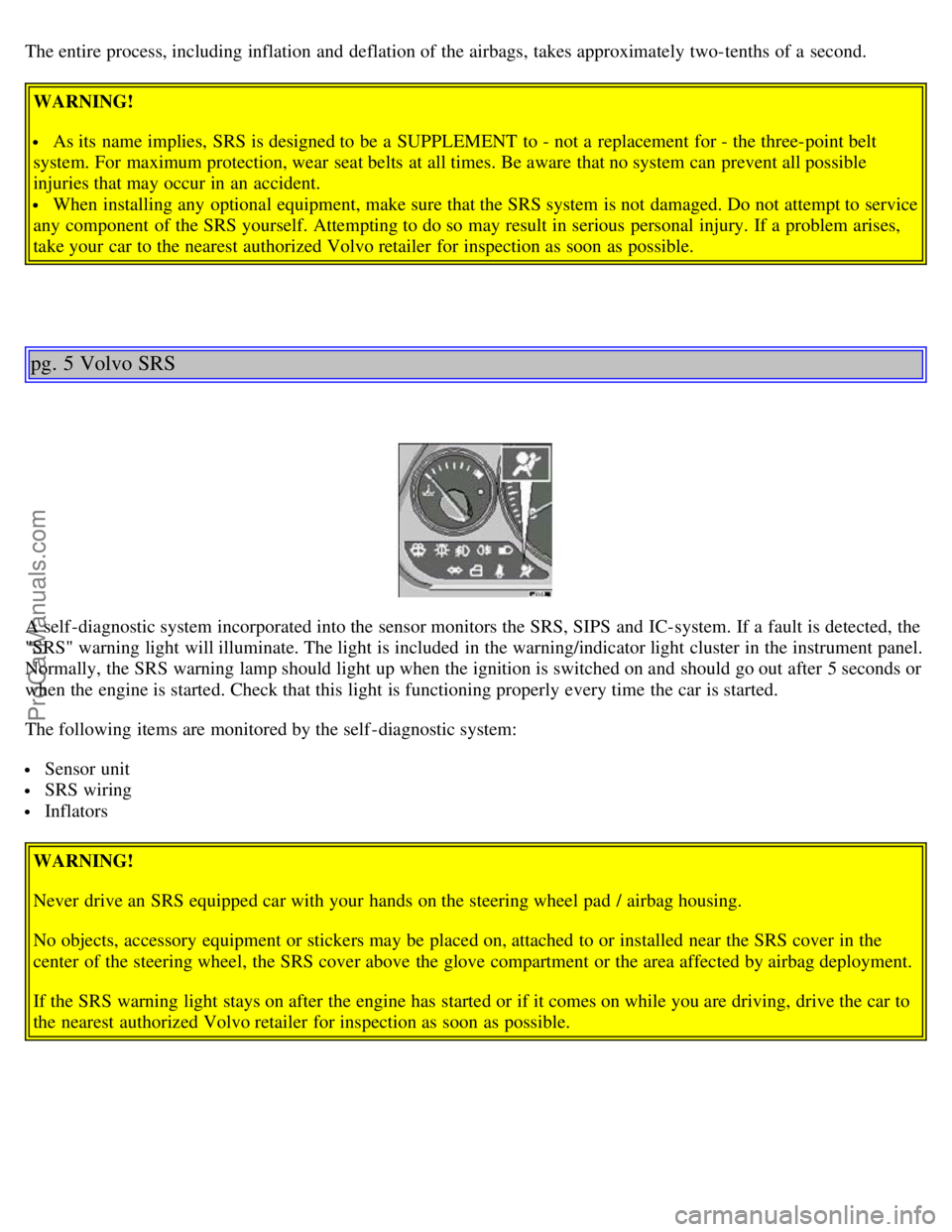
The entire process, including inflation and deflation of the airbags, takes approximately two-tenths of a second.
WARNING!
As its name implies, SRS is designed to be a SUPPLEMENT to - not a replacement for - the three-point belt
system. For maximum protection, wear seat belts at all times. Be aware that no system can prevent all possible
injuries that may occur in an accident.
When installing any optional equipment, make sure that the SRS system is not damaged. Do not attempt to service
any component of the SRS yourself. Attempting to do so may result in serious personal injury. If a problem arises,
take your car to the nearest authorized Volvo retailer for inspection as soon as possible.
pg. 5 Volvo SRS
A self -diagnostic system incorporated into the sensor monitors the SRS, SIPS and IC-system. If a fault is detected, the
"SRS" warning light will illuminate. The light is included in the warning/indicator light cluster in the instrument panel.
Normally, the SRS warning lamp should light up when the ignition is switched on and should go out after 5 seconds or
when the engine is started. Check that this light is functioning properly every time the car is started.
The following items are monitored by the self -diagnostic system:
Sensor unit
SRS wiring
Inflators
WARNING!
Never drive an SRS equipped car with your hands on the steering wheel pad / airbag housing.
No objects, accessory equipment or stickers may be placed on, attached to or installed near the SRS cover in the
center of the steering wheel, the SRS cover above the glove compartment or the area affected by airbag deployment.
If the SRS warning light stays on after the engine has started or if it comes on while you are driving, drive the car to
the nearest authorized Volvo retailer for inspection as soon as possible.
ProCarManuals.com
Page 13 of 85
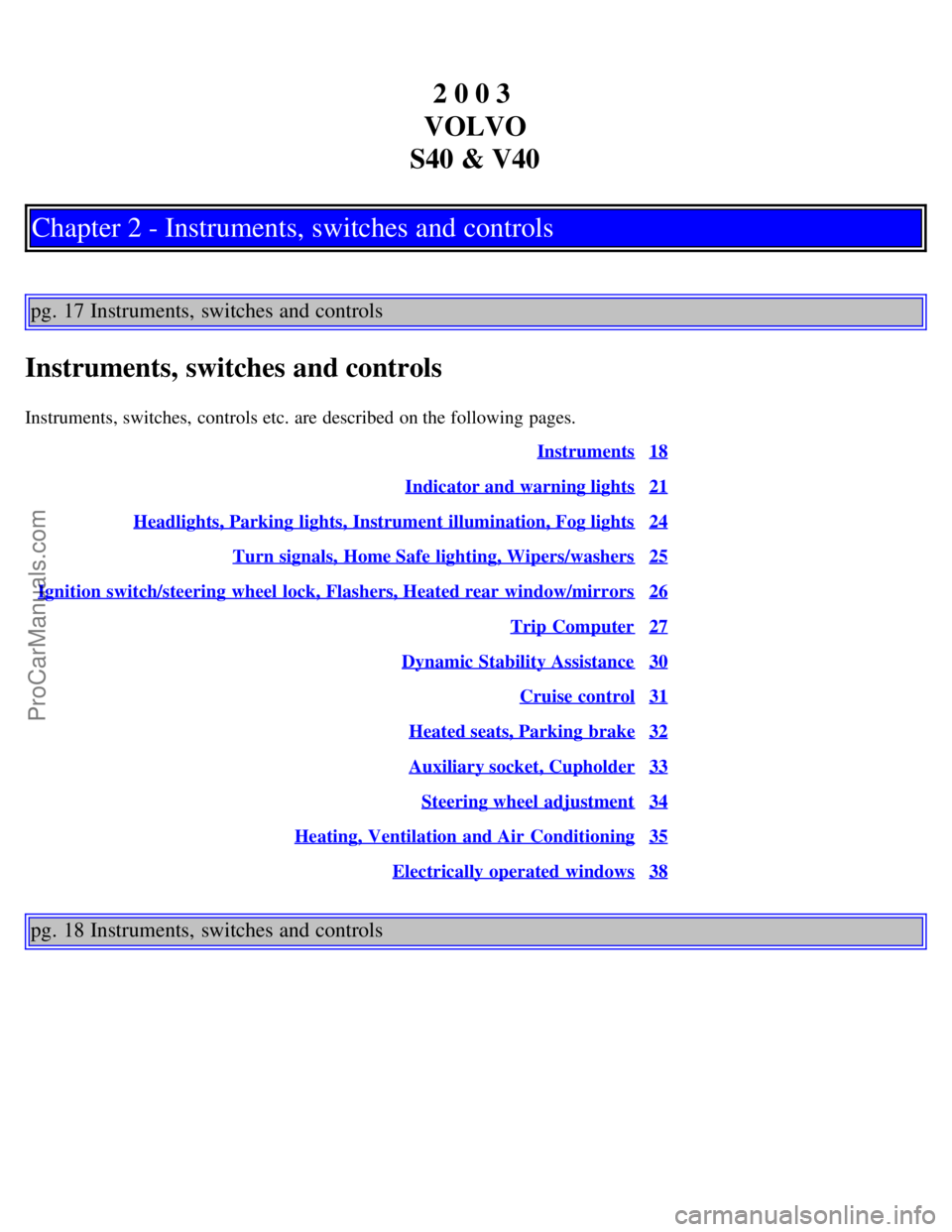
2 0 0 3
VOLVO
S40 & V40
Chapter 2 - Instruments, switches and controls
pg. 17 Instruments, switches and controls
Instruments, switches and controls
Instruments, switches, controls etc. are described on the following pages. Instruments
18
Indicator and warning lights21
Headlights, Parking lights, Instrument illumination, Fog lights24
Turn signals, Home Safe lighting, Wipers/washers25
Ignition switch/steering wheel lock, Flashers, Heated rear window/mirrors26
Trip Computer27
Dynamic Stability Assistance30
Cruise control31
Heated seats, Parking brake32
Auxiliary socket, Cupholder33
Steering wheel adjustment34
Heating, Ventilation and Air Conditioning35
Electrically operated windows38
pg. 18 Instruments, switches and controls
ProCarManuals.com
Page 14 of 85
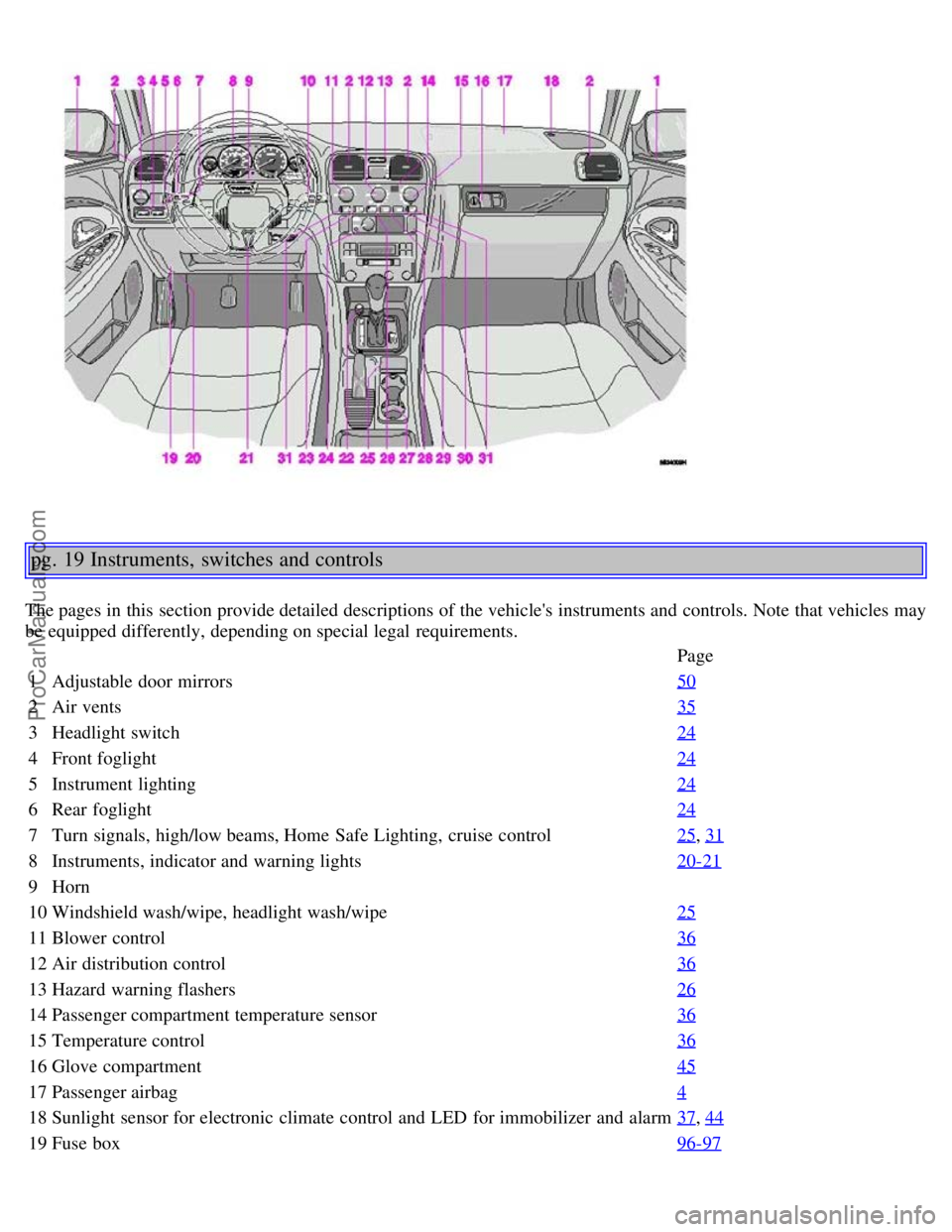
pg. 19 Instruments, switches and controls
The pages in this section provide detailed descriptions of the vehicle's instruments and controls. Note that vehicles may
be equipped differently, depending on special legal requirements.Page
1 Adjustable door mirrors 50
2Air vents 35
3Headlight switch 24
4Front foglight 24
5Instrument lighting 24
6Rear foglight 24
7Turn signals, high/low beams, Home Safe Lighting, cruise control 25, 31
8Instruments, indicator and warning lights 20-21
9Horn
10 Windshield wash/wipe, headlight wash/wipe 25
11Blower control 36
12Air distribution control 36
13Hazard warning flashers 26
14Passenger compartment temperature sensor 36
15Temperature control 36
16Glove compartment 45
17Passenger airbag 4
18Sunlight sensor for electronic climate control and LED for immobilizer and alarm 37, 44
19Fuse box 96-97
ProCarManuals.com
Page 15 of 85

20Hood latch 53
21Steering wheel height adjustment 34
2212-volt electrical outlet 33
23AC on and off 36
24Trip Computer 27
25Coin holder 33
26Recirculation 36-37
27Cupholder 33
28Defroster - door mirrors/rear window 26
29Not in use -
30 Dynamic Stability Assistance (DSA) 30
31Controls for heated front seats 32
32Switch for selecting door mirror left and right 50
33Control for adjusting door mirrors 50
34Door lock switch 42
35Window left and right front 38
36Window left and right rear 38
37Cut -out switch windows rear 38
Some of the items listed on this page are available on certain models only.
pg. 20 Instruments
1 Coolant temperature gauge
Do not drive the car with the pointer in the red range. The pointer should be approximately midway on the gauge
face when driving. If the pointer approaches the red range repeatedly, check coolant level. See page 117
.
2 Coolant temperature warning light
ProCarManuals.com
Page 16 of 85
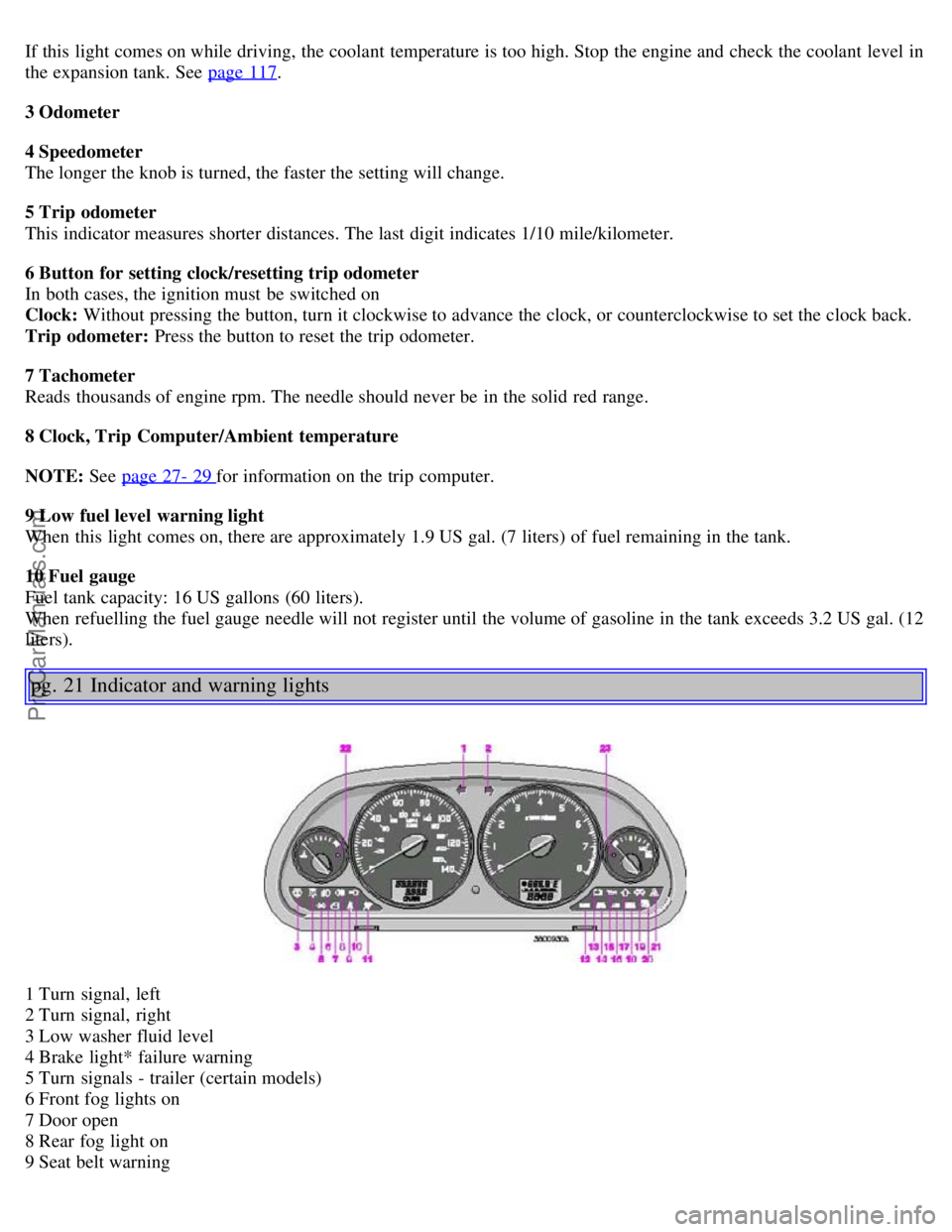
If this light comes on while driving, the coolant temperature is too high. Stop the engine and check the coolant level in
the expansion tank. See page 117.
3 Odometer
4 Speedometer
The longer the knob is turned, the faster the setting will change.
5 Trip odometer
This indicator measures shorter distances. The last digit indicates 1/10 mile/kilometer.
6 Button for setting clock/resetting trip odometer
In both cases, the ignition must be switched on
Clock: Without pressing the button, turn it clockwise to advance the clock, or counterclockwise to set the clock back.
Trip odometer: Press the button to reset the trip odometer.
7 Tachometer
Reads thousands of engine rpm. The needle should never be in the solid red range.
8 Clock, Trip Computer/Ambient temperature
NOTE: See page 27- 29
for information on the trip computer.
9 Low fuel level warning light
When this light comes on, there are approximately 1.9 US gal. (7 liters) of fuel remaining in the tank.
10 Fuel gauge
Fuel tank capacity: 16 US gallons (60 liters).
When refuelling the fuel gauge needle will not register until the volume of gasoline in the tank exceeds 3.2 US gal. (12
liters).
pg. 21 Indicator and warning lights
1 Turn signal, left
2 Turn signal, right
3 Low washer fluid level
4 Brake light* failure warning
5 Turn signals - trailer (certain models)
6 Front fog lights on
7 Door open
8 Rear fog light on
9 Seat belt warning
ProCarManuals.com
Page 17 of 85
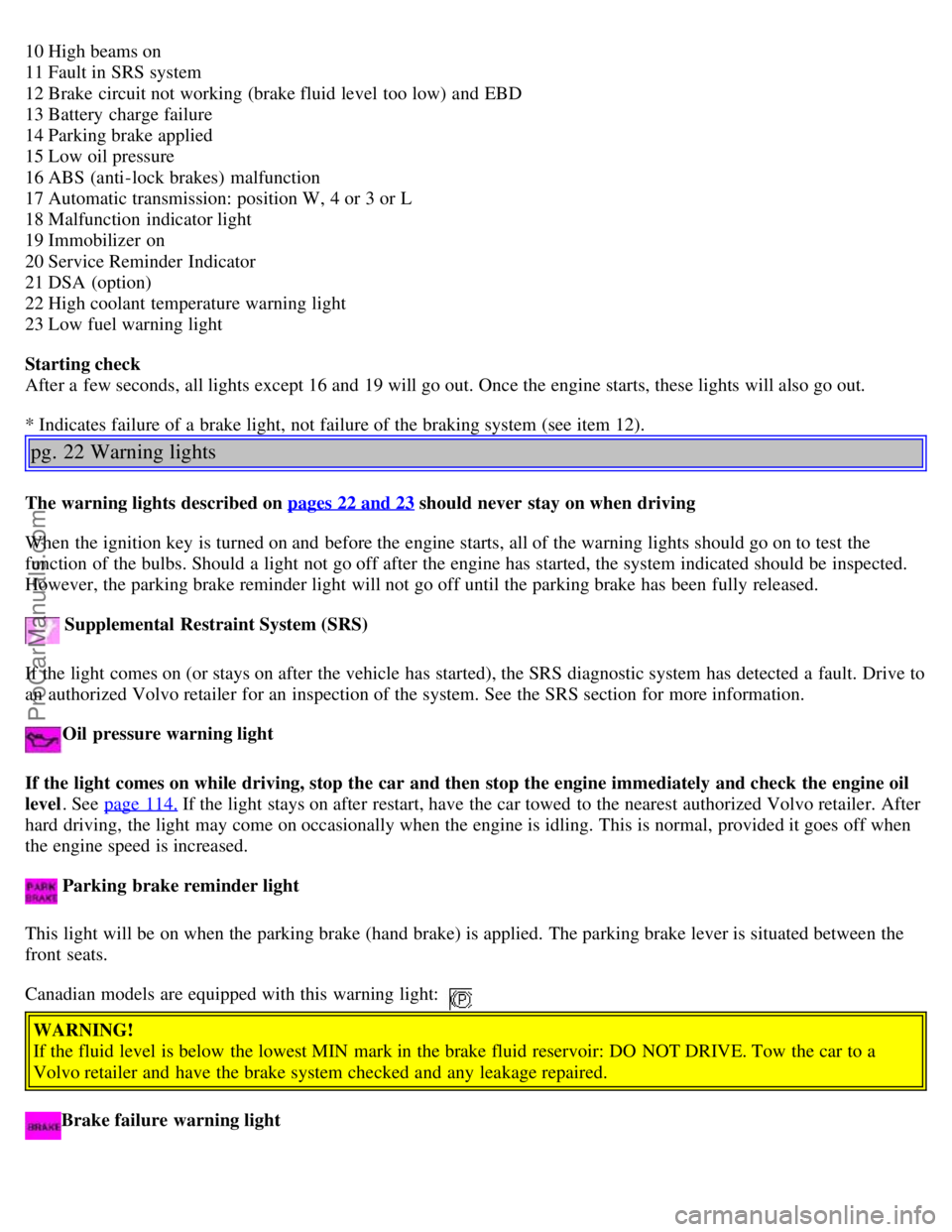
10 High beams on
11 Fault in SRS system
12 Brake circuit not working (brake fluid level too low) and EBD
13 Battery charge failure
14 Parking brake applied
15 Low oil pressure
16 ABS (anti-lock brakes) malfunction
17 Automatic transmission: position W, 4 or 3 or L
18 Malfunction indicator light
19 Immobilizer on
20 Service Reminder Indicator
21 DSA (option)
22 High coolant temperature warning light
23 Low fuel warning light
Starting check
After a few seconds, all lights except 16 and 19 will go out. Once the engine starts, these lights will also go out.
* Indicates failure of a brake light, not failure of the braking system (see item 12).
pg. 22 Warning lights
The warning lights described on pages 22 and 23 should never stay on when driving
When the ignition key is turned on and before the engine starts, all of the warning lights should go on to test the
function of the bulbs. Should a light not go off after the engine has started, the system indicated should be inspected.
However, the parking brake reminder light will not go off until the parking brake has been fully released.
Supplemental Restraint System (SRS)
If the light comes on (or stays on after the vehicle has started), the SRS diagnostic system has detected a fault. Drive to
an authorized Volvo retailer for an inspection of the system. See the SRS section for more information.
Oil pressure warning light
If the light comes on while driving, stop the car and then stop the engine immediately and check the engine oil
level . See page 114.
If the light stays on after restart, have the car towed to the nearest authorized Volvo retailer. After
hard driving, the light may come on occasionally when the engine is idling. This is normal, provided it goes off when
the engine speed is increased.
Parking brake reminder light
This light will be on when the parking brake (hand brake) is applied. The parking brake lever is situated between the
front seats.
Canadian models are equipped with this warning light:
WARNING!
If the fluid level is below the lowest MIN mark in the brake fluid reservoir: DO NOT DRIVE. Tow the car to a
Volvo retailer and have the brake system checked and any leakage repaired.
Brake failure warning light
ProCarManuals.com
Page 18 of 85
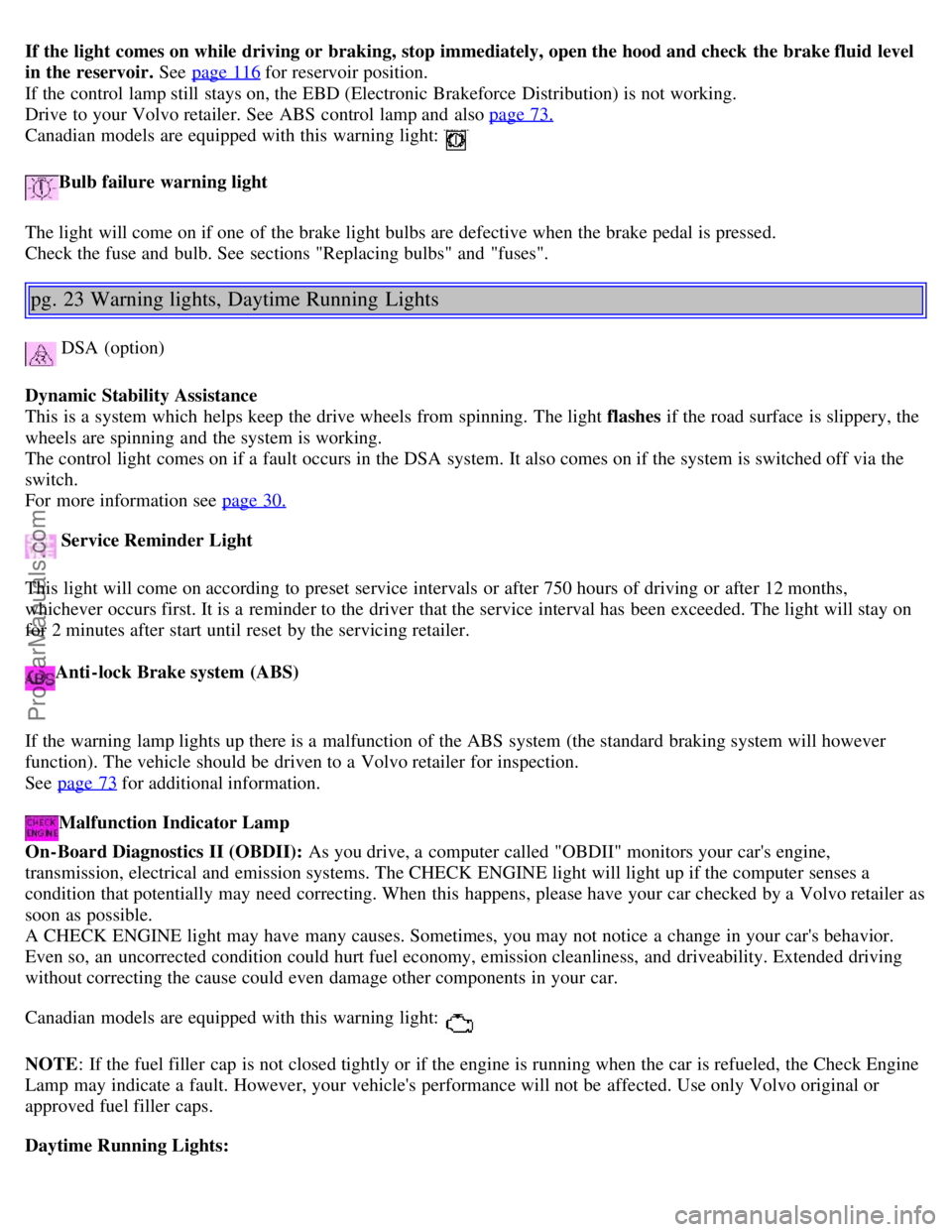
If the light comes on while driving or braking, stop immediately, open the hood and check the brake fluid level
in the reservoir. See page 116 for reservoir position.
If the control lamp still stays on, the EBD (Electronic Brakeforce Distribution) is not working.
Drive to your Volvo retailer. See ABS control lamp and also page 73.
Canadian models are equipped with this warning light:
Bulb failure warning light
The light will come on if one of the brake light bulbs are defective when the brake pedal is pressed.
Check the fuse and bulb. See sections "Replacing bulbs" and "fuses".
pg. 23 Warning lights, Daytime Running Lights
DSA (option)
Dynamic Stability Assistance
This is a system which helps keep the drive wheels from spinning. The light flashes if the road surface is slippery, the
wheels are spinning and the system is working.
The control light comes on if a fault occurs in the DSA system. It also comes on if the system is switched off via the
switch.
For more information see page 30.
Service Reminder Light
This light will come on according to preset service intervals or after 750 hours of driving or after 12 months,
whichever occurs first. It is a reminder to the driver that the service interval has been exceeded. The light will stay on
for 2 minutes after start until reset by the servicing retailer.
Anti-lock Brake system (ABS)
If the warning lamp lights up there is a malfunction of the ABS system (the standard braking system will however
function). The vehicle should be driven to a Volvo retailer for inspection.
See page 73
for additional information.
Malfunction Indicator Lamp
On-Board Diagnostics II (OBDII): As you drive, a computer called "OBDII" monitors your car's engine,
transmission, electrical and emission systems. The CHECK ENGINE light will light up if the computer senses a
condition that potentially may need correcting. When this happens, please have your car checked by a Volvo retailer as
soon as possible.
A CHECK ENGINE light may have many causes. Sometimes, you may not notice a change in your car's behavior.
Even so, an uncorrected condition could hurt fuel economy, emission cleanliness, and driveability. Extended driving
without correcting the cause could even damage other components in your car.
Canadian models are equipped with this warning light:
NOTE : If the fuel filler cap is not closed tightly or if the engine is running when the car is refueled, the Check Engine
Lamp may indicate a fault. However, your vehicle's performance will not be affected. Use only Volvo original or
approved fuel filler caps.
Daytime Running Lights:
ProCarManuals.com
Page 19 of 85
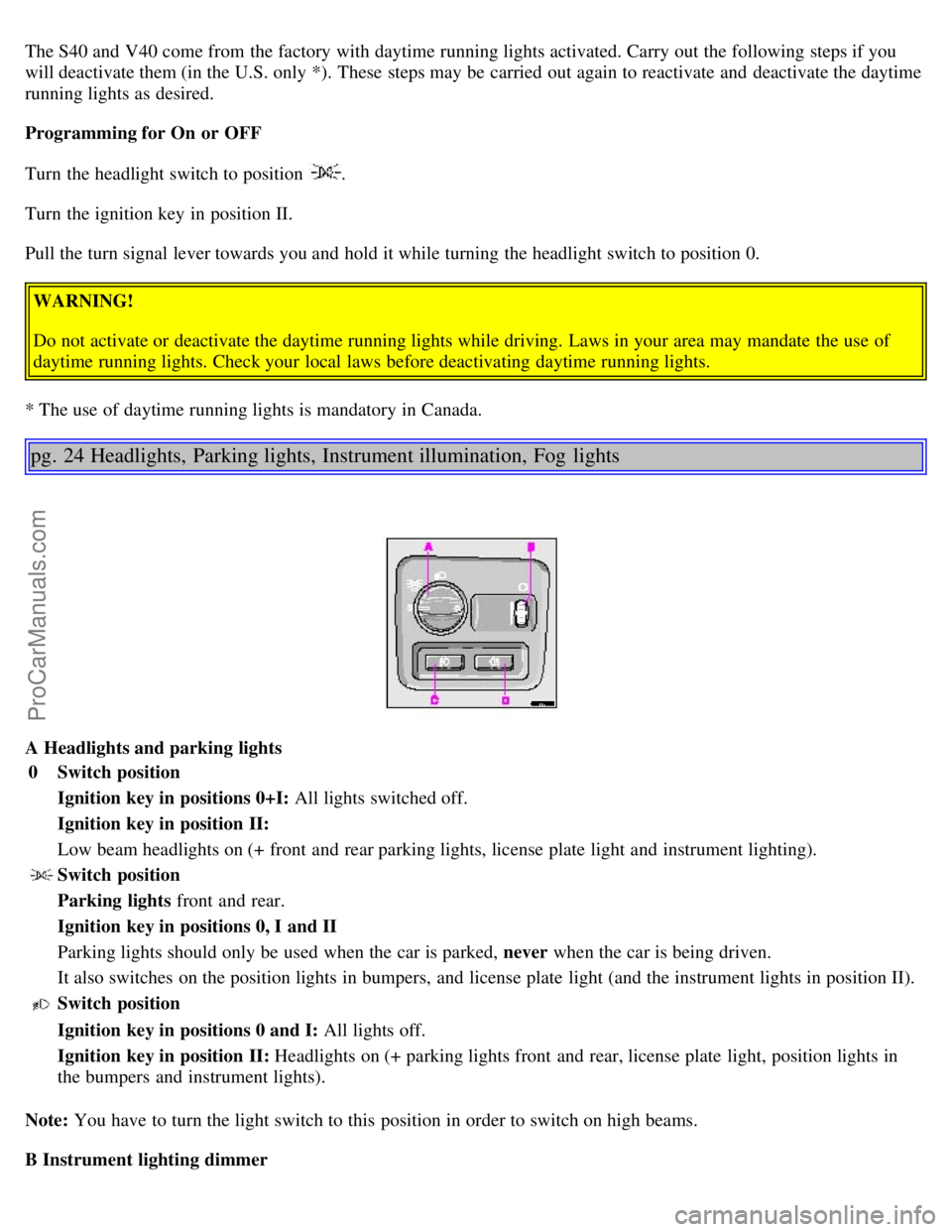
The S40 and V40 come from the factory with daytime running lights activated. Carry out the following steps if you
will deactivate them (in the U.S. only *). These steps may be carried out again to reactivate and deactivate the daytime
running lights as desired.
Programming for On or OFF
Turn the headlight switch to position
.
Turn the ignition key in position II.
Pull the turn signal lever towards you and hold it while turning the headlight switch to position 0.
WARNING!
Do not activate or deactivate the daytime running lights while driving. Laws in your area may mandate the use of
daytime running lights. Check your local laws before deactivating daytime running lights.
* The use of daytime running lights is mandatory in Canada.
pg. 24 Headlights, Parking lights, Instrument illumination, Fog lights
A Headlights and parking lights 0 Switch position
Ignition key in positions 0+I: All lights switched off.
Ignition key in position II:
Low beam headlights on (+ front and rear parking lights, license plate light and instrument lighting).
Switch position
Parking lights front and rear.
Ignition key in positions 0, I and II
Parking lights should only be used when the car is parked, never when the car is being driven.
It also switches on the position lights in bumpers, and license plate light (and the instrument lights in position II).
Switch position
Ignition key in positions 0 and I: All lights off.
Ignition key in position II: Headlights on (+ parking lights front and rear, license plate light, position lights in
the bumpers and instrument lights).
Note: You have to turn the light switch to this position in order to switch on high beams.
B Instrument lighting dimmer
ProCarManuals.com
Page 24 of 85

"keyless" entry into the passenger compartment or the trunk. You will be supplied with two coded key ring
transmitters, which will enable you to lock/unlock all doors and the trunk/tailgate and fuel filler door from a distance
of 10-15 feet (3-5 meters).
The Remote also activates/deactivates the alarm system that comes standard with this car.
The car can also be locked/unlocked with the key.
This device complies with part 15 of the FCC rules. Operation is subject to the following condition: (1) This device
may not cause harmful interference, and (2) this device must accept any interference received, including interference
that may cause undesired operation.
Using the remote control
Press the LOCK button once to lock all doors and trunk/tailgate.
Press the UNLOCK button once to unlock the driver's door and the fuel filler door only. Press this button again
(within 10 seconds) to unlock other doors, trunk/tailgate.
Press the OPEN trunk/tailgate button to unlock the tailgate/trunk.
NOTE : If only the driver's door is unlocked, the lock will automatically reengage (re-lock) and the alarm will be set
after 2 minutes unless the door has been opened.
The lock/unlock and alarm features can also be utilized by using the keys. See the following page.
Remote control not functioning.
If the remote control is not functioning, the car can be opened using the master or service key in the driver's door.
Note: The remote control will not function if a key is left in the ignition switch.
WARNING!
Volvo does not recommend using the transmitter to lock the doors from inside the car. The alarm would be activated
and would sound when one of the doors is opened. The doors must not be locked using the remote transmitter while
the vehicle is occupied. In case of an accident, this may hinder rapid access to the occupants of the vehicle.
*Panic function
In an emergency situation, this feature can be used to attract attention, if you are within 10-15 feet (3-5) meters of the
car.
Activate the "panic" function by pressing the red panic button on the remote control for at least 3 seconds or by
pressing this button twice within 3 seconds. The turn signals will flash, the interior lights will go on and the alarm will
sound.
The "panic" alarm can be turned off after 5 seconds by pressing any of the buttons on the remote control or it
will stop automatically after 25 seconds.
NOTE: The panic button will NOT unlock the car.
pg. 42 Doors and locks
Doors and locks
Your car is equipped with a central locking system.
The key (used on the driver's door) the remote control, or central locking button, will lock/unlock all doors,
trunk/tailgate.
Turn the key once to unlock the driver's door and the fuel filler door.
ProCarManuals.com
Page 29 of 85
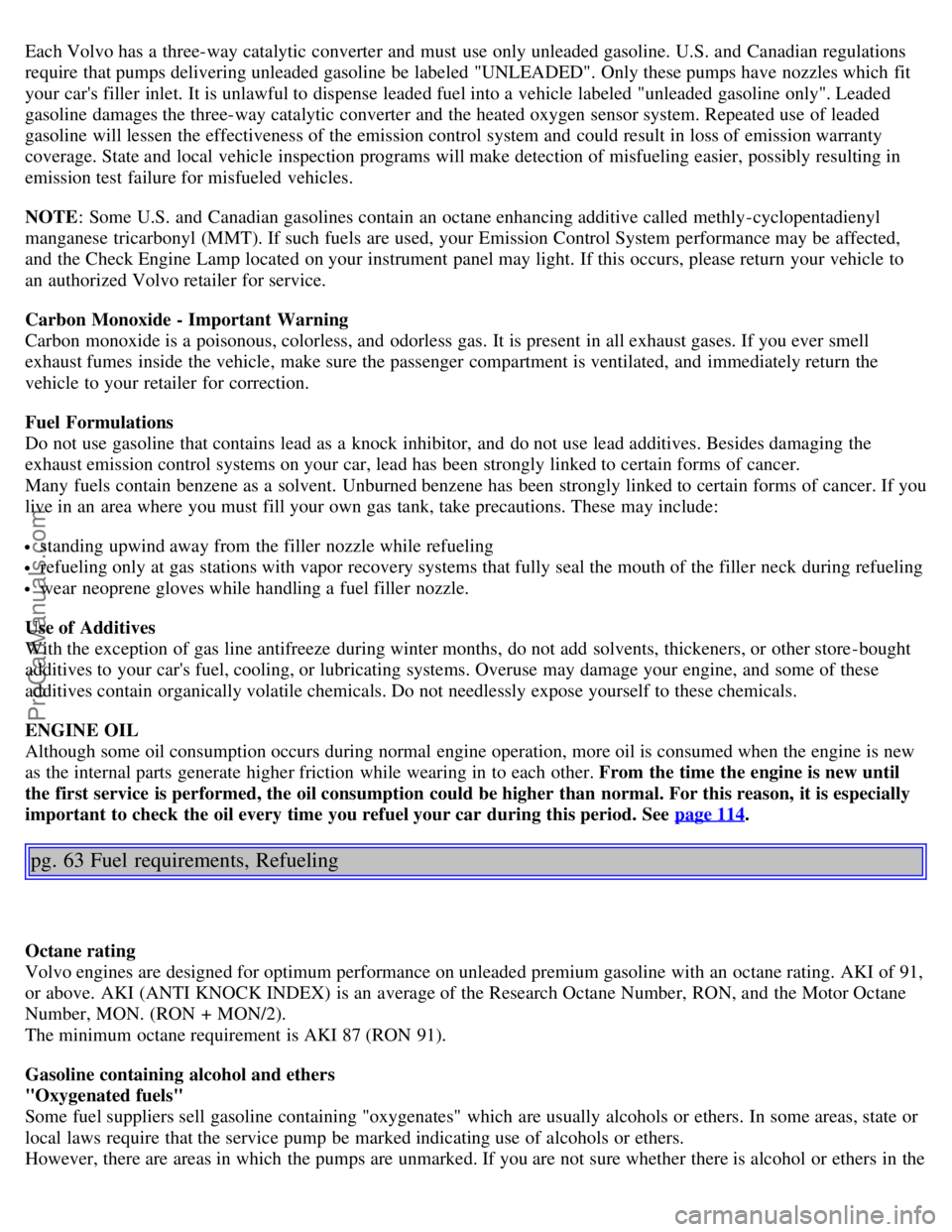
Each Volvo has a three-way catalytic converter and must use only unleaded gasoline. U.S. and Canadian regulations
require that pumps delivering unleaded gasoline be labeled "UNLEADED". Only these pumps have nozzles which fit
your car's filler inlet. It is unlawful to dispense leaded fuel into a vehicle labeled "unleaded gasoline only". Leaded
gasoline damages the three-way catalytic converter and the heated oxygen sensor system. Repeated use of leaded
gasoline will lessen the effectiveness of the emission control system and could result in loss of emission warranty
coverage. State and local vehicle inspection programs will make detection of misfueling easier, possibly resulting in
emission test failure for misfueled vehicles.
NOTE: Some U.S. and Canadian gasolines contain an octane enhancing additive called methly-cyclopentadienyl
manganese tricarbonyl (MMT). If such fuels are used, your Emission Control System performance may be affected,
and the Check Engine Lamp located on your instrument panel may light. If this occurs, please return your vehicle to
an authorized Volvo retailer for service.
Carbon Monoxide - Important Warning
Carbon monoxide is a poisonous, colorless, and odorless gas. It is present in all exhaust gases. If you ever smell
exhaust fumes inside the vehicle, make sure the passenger compartment is ventilated, and immediately return the
vehicle to your retailer for correction.
Fuel Formulations
Do not use gasoline that contains lead as a knock inhibitor, and do not use lead additives. Besides damaging the
exhaust emission control systems on your car, lead has been strongly linked to certain forms of cancer.
Many fuels contain benzene as a solvent. Unburned benzene has been strongly linked to certain forms of cancer. If you
live in an area where you must fill your own gas tank, take precautions. These may include:
standing upwind away from the filler nozzle while refueling
refueling only at gas stations with vapor recovery systems that fully seal the mouth of the filler neck during refueling
wear neoprene gloves while handling a fuel filler nozzle.
Use of Additives
With the exception of gas line antifreeze during winter months, do not add solvents, thickeners, or other store -bought
additives to your car's fuel, cooling, or lubricating systems. Overuse may damage your engine, and some of these
additives contain organically volatile chemicals. Do not needlessly expose yourself to these chemicals.
ENGINE OIL
Although some oil consumption occurs during normal engine operation, more oil is consumed when the engine is new
as the internal parts generate higher friction while wearing in to each other. From the time the engine is new until
the first service is performed, the oil consumption could be higher than normal. For this reason, it is especially
important to check the oil every time you refuel your car during this period. See page 114
.
pg. 63 Fuel requirements, Refueling
Octane rating
Volvo engines are designed for optimum performance on unleaded premium gasoline with an octane rating. AKI of 91,
or above. AKI (ANTI KNOCK INDEX) is an average of the Research Octane Number, RON, and the Motor Octane
Number, MON. (RON + MON/2).
The minimum octane requirement is AKI 87 (RON 91).
Gasoline containing alcohol and ethers
"Oxygenated fuels"
Some fuel suppliers sell gasoline containing "oxygenates" which are usually alcohols or ethers. In some areas, state or
local laws require that the service pump be marked indicating use of alcohols or ethers.
However, there are areas in which the pumps are unmarked. If you are not sure whether there is alcohol or ethers in the
ProCarManuals.com